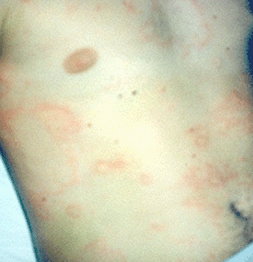
The activated mast cells also release newly formed lipid mediators ( leukotrienes and prostaglandins from membrane arachadonic acid metabolism) and cytokines such as tumor necrosis factor ( Table 19.2). Preformed components that are released from granules include histamine, serotonin, and bradykinin ( Table 19.1). Within minutes, this cross-linking of IgE activates the mast cells and triggers degranulation, a reaction in which the contents of the granules in the mast cell are released into the extracellular environment. On subsequent exposure, allergens bind to multiple IgE molecules on mast cells, cross-linking the IgE molecules. By the time this occurs, the allergen is often no longer present and there is no allergic reaction, but the mast cells are primed for a subsequent exposure and the individual is sensitized to the allergen. It is estimated that each mast cell can bind up to 500,000 IgE molecules, with each IgE molecule having two allergen-specific fragment antigen-binding (Fab) sites available for binding allergen on subsequent exposures. The fragment crystallizable (Fc) regions of the IgE antibodies bind to specific receptors on the surface of mast cells throughout the body.

Cytokines interleukin (IL)-4 and IL-13 from the T H2 cells activate B cells specific to the same allergen, resulting in clonal proliferation, differentiation into plasma cells, and antibody-class switch from production of IgM to production of IgE. (c) Peanuts can be eaten safely by most people but can provoke severe allergic reactions in sensitive individuals.įor susceptible individuals, a first exposure to an allergen activates a strong T H2 cell response ( Figure 19.3).
TYPE 3 HYPERSENSITIVITY REACTION SKIN
(b) Skin rashes are often associated with allergic reactions. Regardless of the allergen, the first exposure activates a primary IgE antibody response that sensitizes an individual to type I hypersensitivity reaction upon subsequent exposure.įigure 19.2 (a) Allergens in plant pollen, shown here in a colorized electron micrograph, may trigger allergic rhinitis or hay fever in sensitive individuals. Food intolerances can also yield allergic reactions as individuals become sensitized to foods such as peanuts or shellfish ( Figure 19.2). Allergens may also be substances considered innately more hazardous, such as insect venom or therapeutic drugs. Allergens may be seemingly harmless substances such as animal dander, molds, or pollen. Such a response is called an allergy and is classified as a type I hypersensitivity. When a presensitized individual is exposed to an allergen, it can lead to a rapid immune response that occurs almost immediately. Type IV hypersensitivity reactions are T-cell–mediated reactions that can involve tissue damage mediated by activated macrophages and cytotoxic T cells.Accumulation of immune complexes in tissue leads to tissue damage mediated by other immune system effectors. Type III hypersensitivity reactions involve the interactions of IgG, IgM, and, occasionally, IgA 1 antibodies with antigen to form immune complexes.Type II hypersensitivity reactions involve IgG and IgM antibodies directed against cellular antigens, leading to cell damage mediated by other immune system effectors.Type I hypersensitivity reactions involve immunoglobulin E (IgE) antibody against soluble antigen, triggering mast cell degranulation.Hypersensitivity reactions are classified by their immune mechanism. However, these same protective immune defenses can also be responsible for undesirable reactions called hypersensitivity reactions. In Adaptive Specific Host Defenses, we discussed the mechanisms by which adaptive immune defenses, both humoral and cellular, protect us from infectious diseases. Are there conditions that might be brought on by sun exposure that Kerry’s physician should be considering?.Is Kerry right to be concerned, or should she simply be more careful about sun exposure?.Lately, the rashes have also begun to appear on her cheeks and above her eyes on either side of her forehead. The rash persists for 7 to 10 days each time, and it seems to largely go away on its own. Despite these precautions, the rash still appears, manifesting as red, raised patches that get slightly scaly. She is careful not to spend too much time in the sun and she uses sunscreen. As she explains to her physician, it does not seem like sunburn.

Kerry, a 40-year-old airline pilot, has made an appointment with her primary care physician to discuss a rash that develops whenever she spends time in the sun.


 0 kommentar(er)
0 kommentar(er)
